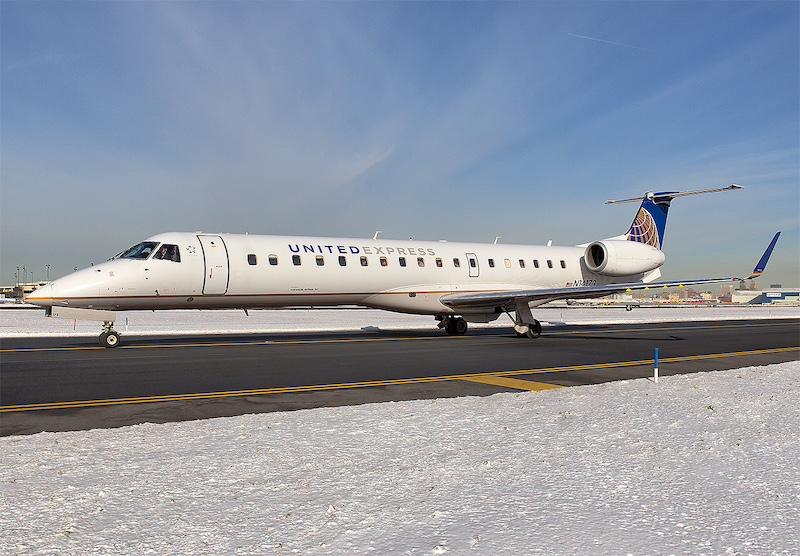
A CommutAir ERJ 145, the type of aircraft described in this article.
Confirmation bias is a type of cognitive bias that involves a tendency to seek information to support one’s belief instead of information that is contrary to that belief.
We all know that when we look up at minimums the runway should be in front of us. In my 40 years of flying out of Westchester County Airport, there were only two times when I didn’t see the airport at minimums. Both times there was a friend in another jet, waiting for me to land, as I went around. Those friends reported to me that they “saw your tires go by.”
We know the runway is there. It’s so close to where we have to go around. In the case of CommutAir Flight 4933, the localizer and glideslope information indicated that the jet was aligned with the runway centerline, and the captain stated that the runway was in sight.
But the first officer did not have the runway in sight, and both pilots expressed confusion about what they were seeing outside the aircraft when it was below 100 ft. AGL—the fourth link in the accident chain.
Fifth Link
The first officer noticed during his previous flight to Presque Isle International Airport (PQI), an “incongruency” between the pink needle (providing guidance from the jet’s flight management system) and the green needle (providing guidance from the ILS localizer signal).
Although the first officer shared this information with the captain during the predeparture briefing, neither flight crewmember considered that a navigational air error could be occurring, even though the captain saw a tower (first and second approaches) and the first officer saw a structure with an antenna (first approach).
I’m certainly not a psychologist, but it seems to me that there is another bias here toward “finishing the job.” In other words, the flight had committed to the approach, thus, there could be nothing wrong with the tools pilots were using for that approach.
The crewmembers discounted their confusion about the runway environment and continued the approach, likely because of confirmation bias. The captain was ultimately responsible for the flight. However, according to the report, she demonstrated poor judgment and decision-making when instructing the first officer to stay on the flight instruments as the jet descended below the decision altitude.
Sixth Link
Descending below minimums without a visual was against company policy. By the time the first officer transitioned outside the aircraft, not enough time remained for him to determine the jet’s position in relation to the runway. Although cognitive biases, including confirmation bias, can affect judgment, decision-making and behaviors, a review of the captain’s training records revealed deficiencies in her piloting abilities.
For example, the CommutAir’s vice president of flight operations stated that, while the captain was a De Havilland Canada DHC-8 first officer, she had received a disciplinary letter and agreed not to pursue captain upgrade training and be monitored for nine months. Also, in September 2017, the captain received a notice of disapproval from the FAA for her EMB 145 type rating.
In addition, twice in September 2017, CommutAir placed the captain under “increased scrutiny” due to training failures, including a failed proficiency check. Even though the captain received her EMB 145 type rating in October 2017 and later upgraded to captain, her repeated training problems indicated an inadequate foundation for being a captain, which CommutAir did not effectively address.
I count this as a link, not because it proves the captain was not up to the task, but, in my mind, the background could have added to the captain’s stress. “I can do this.”
A review of the flight crew’s recent activities determined nothing noteworthy about the captain’s activities and sleep opportunity (7.5 hr.) on the night before was adequate.
Evidence indicated that the first officer was likely fatigued on the day of the accident. Although the first officer stated that he felt rested that day, he had been home with the flu for several days before the accident. Further, the first officer was prescribed a continuous positive airway pressure (CPAP) machine, but he did not consistently use it in the days leading up to the accident.
The daily-use graphic provided in the CPAP download indicated that the first officer used the device very little in the days leading to the accident. Due to his illness and lack of CPAP use, the first officer was likely not obtaining adequate sleep during that period. The first officer commuted to work on the night before the accident flight. He arrived at a local hotel about midnight on March 4 due to flight and shuttle delays.
The first officer went to sleep about 1 a.m. and awoke about 6 a.m., resulting in a sleep opportunity of five hours. The first officer normally slept 7-8 hr.; thus, he had a sleep debt of about 2-3 hr. The quality of his sleep would also have been compromised because he was still coughing and did not use his CPAP. The first officer’s fatigue likely exacerbated the cognitive bias that he experienced during the flight.
Localizer Misalignment
This definitely was a serious link in the chain of events. Both pilots reported that the localizer and glideslope needles were centered during the first and second approaches, indicating that the airplane was aligned with the runway centerline.
Post-accident flight testing of the ILS localizer and glideslope, however, revealed that the localizer was out of tolerance by about 200 ft. to the right. After the accident, the airport conducted snow removal operations in the area around and in front of the localizer array; the snow depths (on the day before removal operations began) ranged from about 2 ft. to 5 ft. After the snow was removed, a flight check determined that the localizer signal was in alignment.
The NTSB finds probable causes that contributed to the accident, and the author adds his assessment, in Part 3 of this article.
To read Links To A Missed Landing In The Snow, Part 1, click here.





